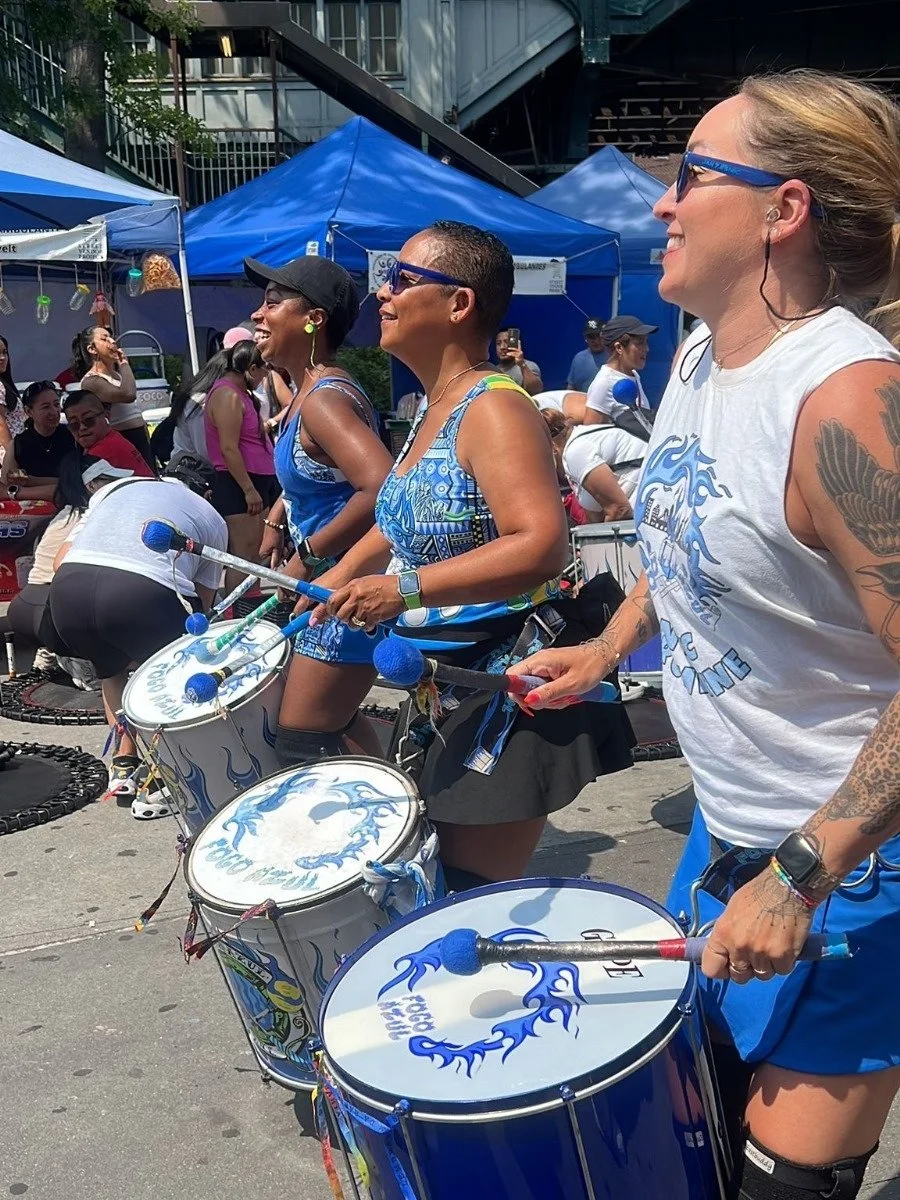What’s That Drum? Dobra and Timbau
Dobra
Perhaps the most iconic drum section of Fogo Azul is the dobra section. This group will most certainly catch your eye during a performance—not only because they are easy to see in the first line of the band, but also because they bring choreography, dance, and energy front and center.
Though the dobra is slightly smaller than a surdo, this drum still measures about 16 by 16 inches, and can also play with power. The dobras sound at a slightly higher pitch than the surdos, and they stand out musically because of the characteristic “offbeat” rhythm that they play. Instead of hitting on the big "heartbeats" 1, 2, 3, and 4 the dobras punctuate the rhythm as they play in between every other big beat.
When I first joined the band, it was impossible to miss Joy—an expert in spinning her sticks and dynamically leading the band from the dobra line. When I asked what she thought was unique about playing the dobra versus the other drums she’s learned, Joy described that the dobra parts boost the groovy feel of the band and make people want to dance! “Plus,” she said, “the dobra section often responds to the repi’s melodic calls…We’re always responding to each other like a Q&A or a conversation where we pose related or contrasting variations around an idea.”
Whether they are playing the offbeat groove, presenting a contrasting rhythm, or dancing when they aren’t busy hitting the drum, dobra players learn to embody the character of the music. For the players that choose to join the dobra section, there is plenty of learning required! A dobra player must become comfortable in their offbeats, bold in their musical interjections, and 100% committed to the section’s choreography. “Once I’ve learned the music and choreo,” Joy explained, “I’m always trying to relax more and think less. Then when I lean into the push-pull of the different drums and my place in it, I can play, dance, and perform more naturally and uninhibitedly.”
“When I lean into the push-pull of the different drums and my place in it, I can play, dance, and perform more naturally and uninhibitedly.”
Timbau (or Timbal)
One exciting development in Fogo Azul’s 2023-24 season was the addition of the timbau into the group. If you've been to a gig with the timbaus this year, you'll certainly have noticed that it is the only drum in the band not played with sticks or mallets of any kind. Instead, the timbau is played directly with the hands.
Coordination and practice are key to achieving the variety of sounds the timbau can make. For example, a strike with the palm in the center of the drum head creates a deeper and stronger hit than the slap of fingers near the edge of the drum head. Put all together, the timbau has a unique musical range that can embody the full groove of the music.
Because timbau is a new addition to the group, all of the players you might see in Fogo are relative beginners on the instrument with ambition to learn this distinctly expressive drum. Joy was one of those members who jumped in as soon as the opportunity presented itself. When I asked how she sees the timbau’s role in the band, Joy described, “To me (a beginner), the timbal is like the musical chatterbox of the group, always making comments and emphasizing rhythms from all other sections of the band.”
Even with experience learning and mastering complex parts in the Dobra and Snare sections, Joy notes that the timbal is perhaps sneakily difficult. When I asked her what it was like to learn this new instrument, she shared, “Honestly, I thought it would be a little more intuitive because I'm tapping rhythms with my fingers all the time!” The variety of hits and rhythms included in timbau parts, though, can be quite complex to learn. Despite the challenges, the group perseveres in growing their musicality on the drum – forming new connections and coordination between brain and body until the playing becomes intuitive.


















